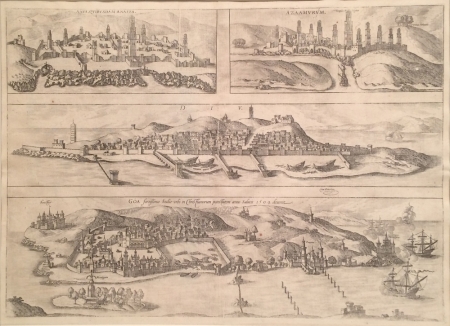Artist / Author / Cartographer:
Title:
Date:
Medium:
Size:
Description:
Four bird's-eye views on one sheet: Casablanca (Anfa) - Azemmour (Azamor) - Diu - Old Goa (Velha Goa)Casablanca (Anfa) - Azemmour (Azamor) - Diu - Old Goa (Velha Goa)
Published by Braun & Hogenburg in Civitates Orbis Terrarum, ... Köln, 1572-1624.
CASABLANCA (ANFA). "Anfa is a large city that was built by the Romans on the shores of the sea and whose location was as good as any city in all Africa. It was razed to the ground for two reasons, however, firstly because it strove too vigorously for freedom and secondly because it caused both Cadiz and the Portuguese much trouble with its pirate ships. The King of Portugal therefore sent 50 well-armed ships to the city, from which the inhabitants fled with all that they could carry. The captain led his forces into the city and in one day laid waste to it and burned the houses to ashes and razed the walls to such an extent that it has remained uninhabited right up to the present."
AZEMMOUR (AZAMOR) Azemmour, or Azamor, lies on the left bank of the Oum Rabie River, some 72 km south of Casablanca. In 1486 the small town started paying a tribute to the Portuguese and in 1508 was conquered by them. In 1513, however, when the local governor Moulay Zayam refused to pay the tribute, the town was destroyed.
DIU. "Diu is an island and also the name of a lovely town that formerly lay under the rule of the city and district of Khambat. Diu lies at the entrance to the Gulf of Cambaia in the Indian Ocean and was fought for and eventually won by the Christians with 23 ships with particular trouble and effort, because Diu had the king of Cambaia, Aden and Calicut on its side."
The engraving shows Diu in cavalier perspective from the sea.
OLD GOA (VELHA GOA). Goa, the fortified city in India, came into the power of the Christians in 1509.
Goa, which lies on a peninsula, is seen across the Mandovi River delta in front of the open sea. A naval battle is depicted on the right: after the Portuguese had discovered the sea route to India in 1489, they used the enmities between the various Indian regional kingdoms to their advantage and in 1510 conquered Goa. The city became the colonial capital of Portuguese India. Portugal would maintain possession of Goa and the surrounding area for 450 years.
References:
Item Code:
attachment:










